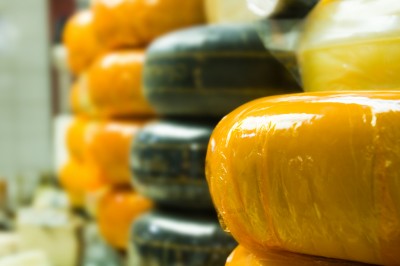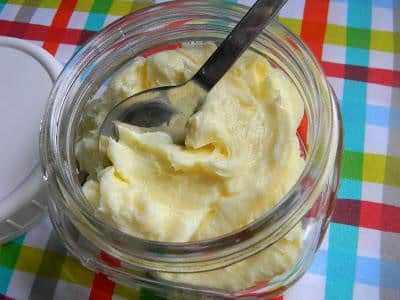 Preserving dairy products is tricky, but it can be done. A part of storing food for emergencies is ensuring that the food you store is nourishing and will keep you and your family fortified for a time when food may not be readily available. Dairy is an important component in a well-balanced diet, and many meals require dairy in their preparation. While you can stock up on evaporated and dried milk, there are also ways of storing dairy in your home that could potentially be less expensive than store-bought items.
Preserving dairy products is tricky, but it can be done. A part of storing food for emergencies is ensuring that the food you store is nourishing and will keep you and your family fortified for a time when food may not be readily available. Dairy is an important component in a well-balanced diet, and many meals require dairy in their preparation. While you can stock up on evaporated and dried milk, there are also ways of storing dairy in your home that could potentially be less expensive than store-bought items.
A note: Some of these methods are not recommended by the USDA for food storage and are presented for information purposes only. While these methods have been used to successfully preserve dairy for many years, utilizing them means you proceed at your own risk.
Milk
Believe it or not, it’s possible to can milk in a pressure cooker. If you own a cow or goat, this is a great way to preserve milk for emergencies and also just for regular cooking needs. Milk can only be canned in a pressure cooker because it’s low acid. To prepare milk for canning, you want to make sure that all the mason jars you use have been washed thoroughly with hot soapy water, and then sterilized by boiling water. When you apply the lids to the mason jars, it’s important that you don’t touch the underside of the lid where is connects to the jar. This might disrupt the seal and make your milk go bad. Keep a close eye on the pressure canner while it’s cooking, because pressure canners can be unpredictable. Even though it’s possible to can milk at home, it’s also a good idea to stock up on canned milk from the store as well. Buying sweetened condensed milk for baking or for coffee is a good idea since it’s harder to make sweetened condensed milk at your house. Your home-canned milk will last for about a year.
Prepare now for surging food costs and empty grocery store shelves…
Another option is to freeze milk, though you may not want to drink it after it’s thawed out. The milk tends to get grainy and will separate when it’s frozen, but a good shake will help it come back together. You can use it for baking and drinking, if you don’t mind the taste. This method of storage should last about 3 months.
You can also buy powdered milk. It’s probably best that you both pressure can and buy milk because canned milk is not for drinking or using on cereal. It’s more for cooking and using in pies and gravies. Powdered milk can come in large bags depending on where you buy it. Powdered milk can last up to five years, especially if it’s packaged well and unopened. It will also last longer if you package it in a reduced oxygen environment by using a vacuum sealer.
Cheese
You might be surprised to find that cheese is actually fairly easy to preserve without refrigeration. Cheese existed long before people had a refrigerator to keep it from going bad, and the methods they used can still be used today for your emergency food store. One method is by covering the cheese with wax. You need to use special cheese wax and not paraffin wax, because paraffin cracks when it dries. To preserve the cheese, begin by melting the cheese wax in a pan. The wax will not totally come off, so know that whatever pan you use will be a wax-pan from that time on. While the wax is melting, cut the cheese into manageable blocks, no more than what you can eat or cook within a few days. Gently brush the melted wax over the cheese using a boar’s hair bristle brush. This specific brush will often be sold with the cheese wax. Within about thirty minutes or so, the wax will be hardened and then you must hang it in a mesh basket in a dark place. Cheese preserved in this way will keep for up to twenty-five years! Make sure you get mild cheese when you start preserving, because it will eventually turn extra sharp.
Cheese can also be frozen, but only a few types hold up well in the freezer and can last for up to six months. Handcrafted cheese and gourmet cheese should never be frozen. Not only does it lose flavor, but it also just doesn’t freeze well. It can disintegrate or just crumble when it’s thawed out. The best cheese to freeze is block grocery store cheese like cheddar, Monterey jack, and provolone. Cheese lasts for a long time in the refrigerator too, but not nearly as long as it will last in the freezer or by preserving it with cheese wax.
Butter
Butter can be preserved a little easier than milk, but not as well as cheese. Butter can be frozen for up to eight months without losing its texture. After eight months, it begins to look like frozen milk and will become grainy and separated. Always freeze butter in its original packaging, and if you like, you can also put it in a Ziploc bag for further protection. Salted butter can last up to two years in the freezer and four months in the refrigerator. Unsalted butter will last about four to five months in the freezer and about three months in the refrigerator.
You also have the ability to can butter. The process of canning butter is a little simpler than canning milk because you don’t need to use a water or pressure canner. Start out with several pounds of butter. About eleven pounds will make a dozen pint jars of canned butter. Put your pint jars in a roasting pan in the oven and heat it at 250 degrees for twenty minutes. While the jars are heating, melt all of your butter until it comes to a boil. Stir often so that the butter won’t scorch at the bottom of the pan. After the butter comes to a boil, lower the heat and simmer for five minutes. While the butter is melting, boil the lids and seals to your pint jars to that they are sanitized. When the jars are done, take them out of the oven and ladle the butter in until there is ¾ inch of headspace at the top. Put the lids and seals on and wait until the jars begin to seal themselves. You will hear a pinging or a popping noise that indicates the jars are sealing.
Once all of the jars have sealed and are cool enough to touch. Shake them so that all the separated butter particles mix together. Place them in the fridge and shake them periodically until they solidify. After this, place them in your pantry. Canned butter will last up to five years unopened. When the butter is opened however, it should be refrigerated after use. If you don’t have the ability to refrigerate after opening, it’s probably better to use the whole thing within a day or two or else the butter could go rancid.
Preserving dairy products is probably the hardest type of food to preserve and store. Since the expiration times of so many dairy products are very short, your options for storing them for long periods of time are limited. However, there are methods of preserving dairy products so that you can have access to them even when there is no power or when you don’t have the ability to go to the store. It’s a good idea to research all the different ways of preserving dairy so that if there is an emergency that restricts your ability to get fresh milk, cheese, and butter, you and your family don’t have to go without. Most people don’t think about what they will do if they can’t get milk and butter, but most meals are prepared with both ingredients; so be prepared and know your options for keeping dairy products in your emergency food storage.
 Off The Grid News Better Ideas For Off The Grid Living
Off The Grid News Better Ideas For Off The Grid Living





